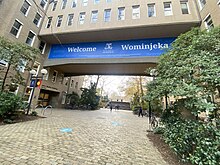
Education in Australia encompasses the sectors of early childhood education (preschool) and primary education, followed by secondary education, and finally tertiary education, which includes higher education and vocational education. Regulation and funding of education is primarily the responsibility of the States and territories; however, the Australian Government also plays a funding role.

International students, or foreign students, are students who undertake all or part of their tertiary education in a country other than their own.

International English Language Testing System is an international standardized test of English language proficiency for non-native English language speakers. It is jointly managed by the British Council, IDP and Cambridge English, and was established in 1989. IELTS is one of the major English-language tests in the world. The IELTS test has two modules: Academic and General Training. IELTS One Skill Retake was introduced in 2023, which allows a test taker to retake any one section of the test.

English as a second or foreign language is the use of English by speakers with different native languages, often with students whose native language is not English and are learning to speak and write English, commonly among students. Language education for people learning English may be known as English as a foreign language (EFL), English as a second language (ESL), English for speakers of other languages (ESOL), English as an additional language (EAL), or English as a new language (ENL), which refers to the practice of studying English in a country where it is not the dominant language. These programs, especially ESL, are usually an academic subject, course, or program designed to teach English to students who are not yet proficient in the language. While some people only refer to learning in an English-speaking country, learning this language can also entail learning in a non-English speaking or non-native nation.

A student exchange program is a program in which students from a secondary school or higher education study abroad at one of their institution's partner institutions. A student exchange program may involve international travel, but does not necessarily require the student to study outside their home country.

The Australian continent was first settled when ancestors of Indigenous Australians arrived via the islands of Maritime Southeast Asia and New Guinea over 50,000 years ago.

The Department of Immigration and Border Protection (DIBP) was a department of the Government of Australia that was responsible for immigration, citizenship and border control. It has now been subsumed into the Department of Home Affairs, which combines its responsibilities with a number of other portfolios.
English Australia, formerly known as the ELICOS Association of Australia, is an industry association of English language schools for students from overseas studying in Australia.
A working holiday visa is a residence permit allowing travellers to undertake employment in the country issuing the visa to supplement their travel funds. For many young people, holding a working holiday visa enables them to experience living in a foreign country without having to find work sponsorship in advance or going on an expensive university exchange programme.

The visa policy of Australia deals with the requirements that a foreign national wishing to enter Australia must meet to obtain a visa, which is a permit to travel, to enter and remain in the country. A visa may also entitle the visa holder to other privileges, such as a right to work, study, etc. and may be subject to conditions.
Working holidays in Australia is a program that enables eligible young people aged between 18 and 30 years to visit Australia and to supplement their travel funds through incidental employment. Forms of working holiday visas have existed since January 1975, designed to "promote international understanding by enabling young people to experience the culture of another country."
The Commonwealth Register of Institutions and Courses for Overseas Students (CRICOS) is a register formed under the Education Services for Overseas Students (ESOS) Act 2000. It maintains a list of institutions, and courses, which have been granted permission by states and territories, to educate overseas students. It is a Federal framework under the authority of state and territory jurisdiction, and providers must register through these agents to legally educate and train international students. CRICOS, in conjunction with other federal and state/territory bodies and legislation, provides strict guidelines for institutions, accepts and/or declines registrations, monitors registered institutions’ compliance and ensures financial capability and stability.

Tertiary education in Australia is formal education beyond high school in Australia, consisting of both government and private institutions and divided into two sectors; Higher Education and Vocational Education and Training (VET) provided by government-owned TAFEs & private Registered Training Organisations (RTO). Australian Qualifications Framework (AQF), the Australian national education policy, classifies tertiary qualification into 10 levels: level 1 to 4 vocational certificates ; level 5 & 6 undergraduate diploma and advanced diploma; level 6 associate degree; level 7 bachelor degree, level 8 bachelor honours degree & graduate certificates and graduate diplomas; level 9 for master's degree; and level 10 PhD. Most universities are government owned and mostly self-regulated. For other institutes there are two national regulators for tertiary education for registration, recognition and quality assurance of both the "provider institutes" as well as the "individual courses" provided by the providers. Tertiary Education Quality and Standards Agency (TEQSA) regulates institutes which provide education from level 5 or above. Australian Skills Quality Authority (ASQA) regulates institutes which provide education from level 1 to level 6.
In Australia, the 457 visa was the most common visa for Australian or overseas employers to sponsor skilled overseas workers to work temporarily in Australia. It was abolished on 18 March 2018 by the Turnbull government and replaced by another visa category. The full title of this subclass of visa was Temporary Business (Long Stay) and was introduced soon after John Howard became Prime Minister in 1996. The title of the visa was changed to Temporary Work (Skilled) (Subclass 457) visa on 24 November 2012. Applications were processed by the Department of Immigration and Border Protection (DIBP). On 18 April 2017, Prime Minister Malcolm Turnbull announced that the 457 visas will be replaced with two new visa categories.
Trinity College London, established in 1872, is a leading international exam board, publisher and independent education charity. Since 1938 Trinity has been offering English language assessments taken by over 850,000 candidates in over 60 countries each year.
Student migration is the movement of students who study outside their country of birth or citizenship for a period of 12 months or more. During the period of globalization, the internationalisation of higher education increased dramatically and it has become a market driven activity. With the rapid rise of international education more and more students are seeking higher education in foreign countries and many international students now consider overseas study a stepping-stone to permanent residency within a country. The contributions that foreign students make to host nation economies, both culturally and financially has encouraged major players to implement further initiatives to facilitate the arrival and integration of overseas students, including substantial amendments to immigration and visa policies and procedures. Institutions are competing hard to attract international students at a time when immigration policies in leading destinations like the US and the UK are not enabling transition to work visas.
The Canadian English Language Proficiency Index Program, or CELPIP, is an English language assessment tool which measures listening, reading, writing, and speaking skills. The test is administered by Paragon Testing Enterprises., a subsidiary of the University of British Columbia (UBC). Paragon is the only Canadian company delivering Immigration, Refugees and Citizenship Canada (IRCC) designated English proficiency tests. The CELPIP test is offered in two versions, CELPIP-General, and CELPIP-General LS.
The Tertiary Education Quality and Standards Agency (TEQSA) is Australia's independent national quality assurance and regulatory agency for higher education.
Teaching English as a second (TESL) orforeign language (TEFL) and teaching English to speakers of other languages (TESOL) are terms that refer to teaching English to students whose first language is not English. The terms TEFL, TESL, and TESOL distinguish between a class's location and student population, and have become problematic due to their lack of clarity. TEFL refers to English-language programs conducted in countries where English is not the primary language, and may be taught at a language school or by a tutor. For some jobs, the minimum TEFL requirement is a 100-hour course; the 120-hour course is recommended, however, since it may lead to higher-paid teaching positions. TEFL teachers may be native or non-native speakers of English.
A family visa is a type of immigration visa issued by the governments of various countries for family reunification purposes in a foreign country.












